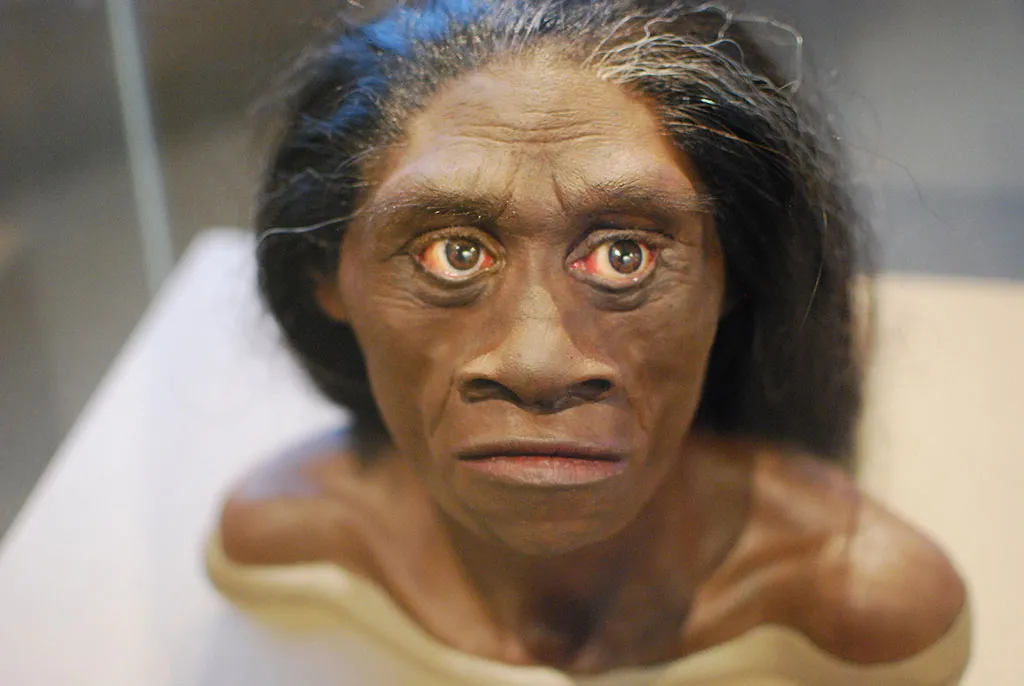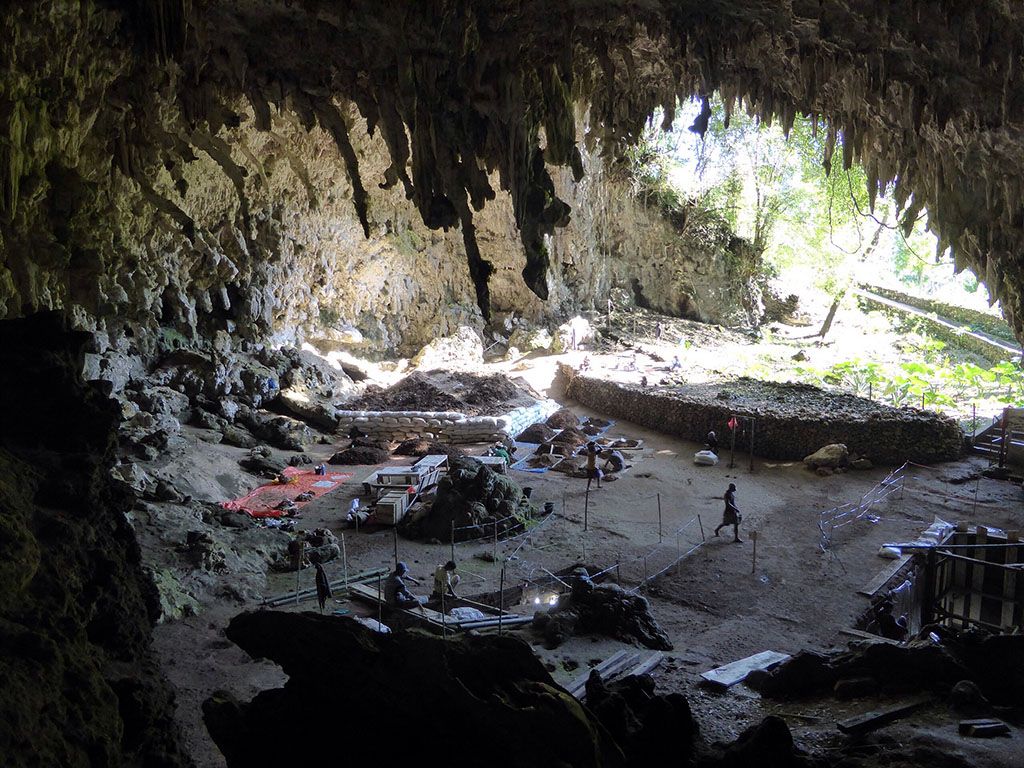Ten Years On, the Flores “Hobbit” Remains an Evolutionary Puzzle
Why was the 2004 unveiling of a small hominin dubbed Homo floresiensis such a big deal?
/https://tf-cmsv2-smithsonianmag-media.s3.amazonaws.com/filer/8c/08/8c08ce12-b07c-48e6-9e4c-b3b045e381f1/dwf15-970101edit.jpg)
The ancient human known as the “Hobbit” has taken evolutionary biologists on a very unexpected journey. Back in 2004, a team led by archaeologists Mike Morwood and Peter Brown announced the discovery of a three-foot-tall hominin skeleton with an exceptionally small stature and skull, found in Liang Bua cave on the island of Flores in Indonesia. A series of papers released in 2009 described even more fossils from the site, including eight more Hobbit individuals.
Known to scientists as Homo floresiensis, the Hobbit has no ordinary skeleton. Although parts of its anatomy resembled those of very ancient humans, dating analysis puts the skeleton at about 18,000 years old. That means the seemingly primitive species lived at the same time as modern humans (Homo sapiens), which appeared about 200,000 years ago. In other words, the Hobbit appears to be the latest surviving human species, aside from our own.
This week marks the anniversary of the first publications in Nature describing the Hobbit, and even after a decade of debate, the tiny skeleton continues to provoke controversy. Some experts argue that the skeleton does not represent its own species and is simply a diseased modern human. It’s easy to get lost in competing theories of where H. floresiensis came from and how it got to Indonesia, so here’s our guide to what scientists know and don’t know about this unusual discovery:
Why is the Hobbit so weird?
At first, archaeologists suspected they were looking at the bones of a modern human child. But closer analysis changed their tune. Older hominins, such as the 3.2-million-year-old Australopithecus afarensis, known from the famous “Lucy” fossil, have reinforced jaws, flared hipbones and short legs. Those same features show up in H. floresiensis. The Hobbit’s small skull indicates that the species had a brain the size of an orange, resembling another ancient species Homo habilis, which lived 2.4 to 1.4 million years ago. The Hobbit also possesses the furrowed brow ridges, thick skull and brain structure of Homo erectus, which appeared nearly 2 million years ago. As the researchers delved deeper, it became clear that H. floresiensis had a curious mix of modern and primitive traits. “It’s kind of like all of a sudden there was this laboratory of human evolution that had been occurring on planet Earth that we didn’t even know about,” says Rick Potts, a paleoanthropologist who directs the National Museum of Natural History’s Human Origins program.

Are we sure the Hobbit isn’t just a really short modern human?
Given the young age of the skeleton, some experts have suggested that H. floresiensis represents a modern human with dwarfism, Down syndrome or other pathologies that might explain the small stature and brain. But no modern human pathology can explain all of the Hobbit’s features. Notably, the wrist bones of H. floresiensis don’t contain certain hallmark features of the foot, face and wrist bones of modern humans, such as a boot-shaped trapezoid bone in our wrists. That hasn’t stopped scientists from arguing about whether H. floresiensis truly constitutes a unique species.
So where (evolutionarily speaking) did the Hobbit come from?
Not the Shire. Perhaps the most widely accepted scenario is that H. floresiensis evolved from a version of H. erectus. Coincidentally, H. erectus remains have turned up on the Indonesian island of Java. The earliest H. erectus fossils unearthed outside of Africa, at Dmanisi in Georgia, have also shown that these hominins were not always the large strapping specimens we suspected them to be. Dmanisi skeletons are smaller and retain some primitive features. This all hints that a group of early H. erectus could have made its way to mainland Southeast Asia, and a rogue population could have then been stranded on Flores and given rise to the Hobbit.
Could its origins be even older?
That would certainly make things interesting. Given the similarities in anatomy to both Lucy and Homo habilis, it’s possible that the Hobbit had an older ancestor. If that were the case, we’d need to rethink the spread of ancient humans out of Africa. “It would mean that a whole branch of a human evolutionary tree in Asia had been missing until those fateful discoveries in Liang Bua,” writes Chris Stringer, an anthropologist at the Natural History Museum in London, in a comment paper published in Nature today. However, an Australopithecus species like Lucy probably couldn’t have made the trek from Africa across Asia to Indonesia—it isn’t until the rise of Homo erectus that we see legs strong enough for walking long distances.

Homo erectus wasn’t exactly petite. How did the Hobbit get so small?
In short, it shrunk. The leading theories suggest that the ancestor of H. floresiensis may have been subject to insular or island dwarfism. Islands come with a unique set of evolutionary pressures, among them limited and sometimes unreliable resources. To compensate, some animals evolve smaller body sizes that require less energy to maintain. “If you want to survive on an island, you have to basically shrink down all of the organs of the body that are expensive,” says Potts. Animal remains unearthed with H. floresiensis at Liang Bua included a dwarf species of primitive elephant called a Stegodon, along with normal-sized Komodo dragons. Morwood and Brown posited that since island dwarfism was at play on Flores, it could have shaped the Hobbit and may explain the re-emergence of primitive skeletal traits.
And why is its brain so small?
Proponents of more modern origins for H. floresiensis have linked the small brain size to developmental disorders like microcephaly, which stunts the brain’s growth. Initially, researchers questioned whether island dwarfism could indeed shrink the brain to the degree seen in H. floresiensis. But a 2009 study published in Nature found that in hippos undergoing island dwarfism on Madagascar, the brain does get disproportionally smaller than the body. A big brain requires a lot of expensive upkeep, so it makes sense that the brain might be subject to stronger evolutionary pressures.
How did the Hobbit get to Flores?
Even during the last glacial maximum, when sea levels dropped drastically, Flores would not have been accessible from other Indonesian islands or mainland Southeast Asia. The ancestors of H. floresiensis would have needed a boat or raft. Though not out of the realm of possibility, there’s no evidence that H. erectus built boats. More likely, a population of early H. erectus got stranded on a piece of vegetation or land, a micro-island of sorts, that broke off from the mainland and bumped into Flores—this is actually not uncommon in coastal areas during a typhoon or tsunami.

When did the Hobbit get to Flores?
The initial dating of volcanic ash in the sediment around the H. floresiensis fossils puts the bones between 38,000 and 18,000 years old. But other archaeological evidence, such as stone tools in Liang Bua cave, spans from 94,000 to 13,000 years ago. Smithsonian researchers are performing dating analyses on the skeletons in hopes of refining the Hobbit’s age. The oldest stone tools found on Flores date to 1.02 million years ago and may have belonged to H. floresiensis, or more likely their ancestors.
What answers will the next ten years bring?
Any future skeletons unearthed at Liang Bua or elsewhere on Flores could fill in some blanks and probably settle the million-dollar question of the Hobbit’s origins. That answer could impact how we imagine human evolution on mainland Asia and even how we think about human migration out of Africa.
/https://tf-cmsv2-smithsonianmag-media.s3.amazonaws.com/accounts/headshot/Screen_Shot_2014-01-27_at_12.05.16_PM.png)
/https://tf-cmsv2-smithsonianmag-media.s3.amazonaws.com/accounts/headshot/Screen_Shot_2014-01-27_at_12.05.16_PM.png)